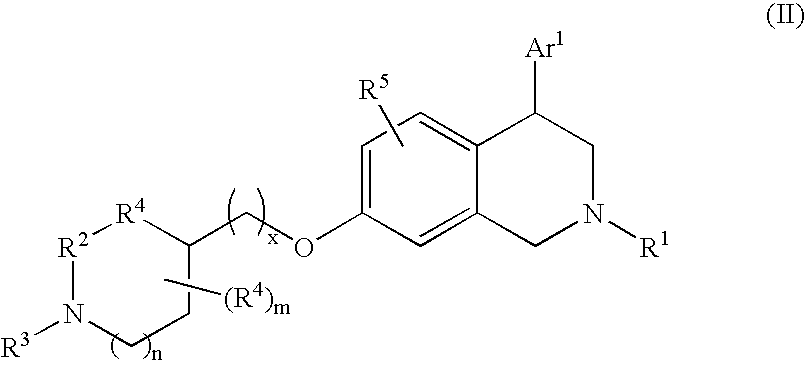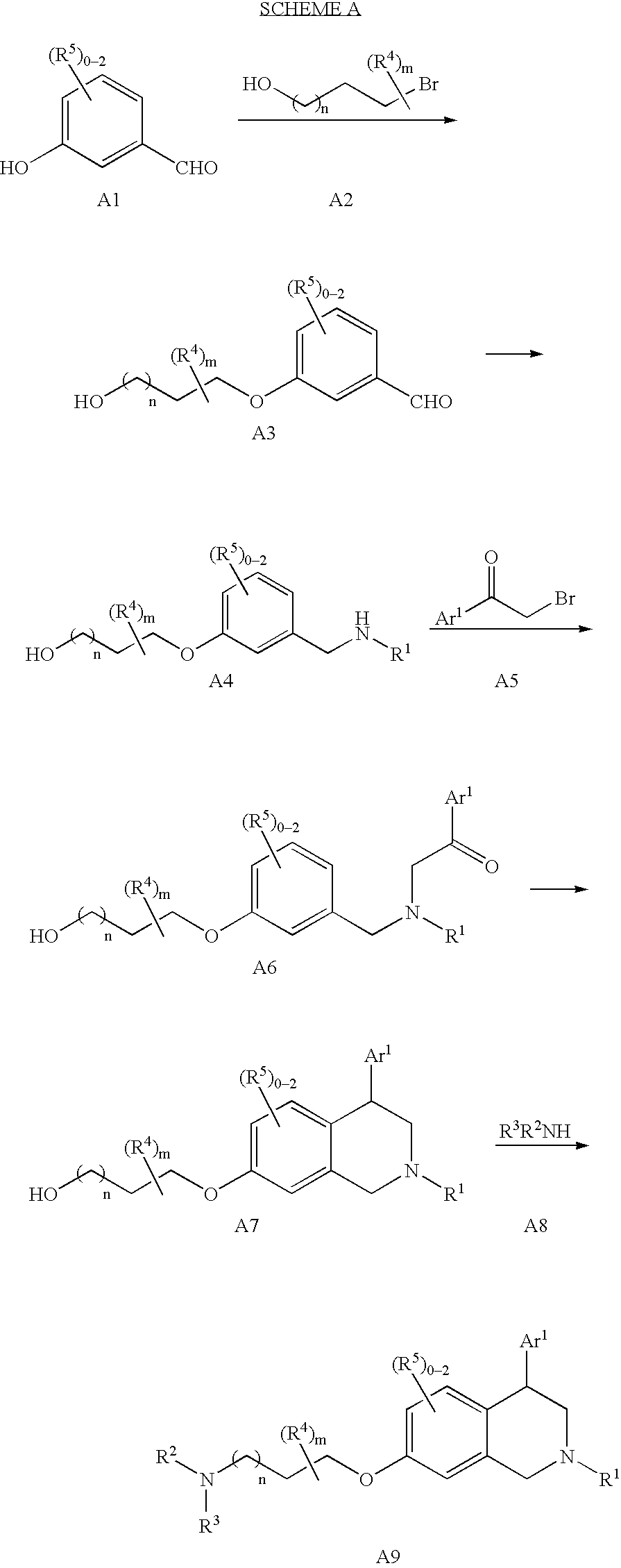Tetrahydroisoquinoline compounds
a technology of isoquinoline and compounds, applied in the field of tetrahydroisoquinoline compounds, can solve the problems of limiting its availability in synaptic clefts, affecting the treatment effect of depression, and affecting the treatment effect, and achieves the effect of treating depression counterbalanced by numerous unwanted side effects
- Summary
- Abstract
- Description
- Claims
- Application Information
AI Technical Summary
Benefits of technology
Problems solved by technology
Method used
Image
Examples
example 1 (
racemic), 1A (enantiomer 1), and 1B (enantiomer 2)
7-[3-(4-Fluoro-piperidin-1-yl)-propoxy]-4-(4-methoxy-phenyl)-2-methyl-1,2,3,4-tetrahydro-isoquinoline
[0170] Step 1; 3-(3-Hydroxy-propoxy)-benzaldehyde. To a mixture of 3-hydroxybenzaldehyde (40.0 g, 328 mmol) and K2CO3 (68.0 g, 491 mmol) in acetonitrile (650 mL) was added 3-bromo-propan-1-ol (54.6 g, 393 mmol) and the mixture was heated at reflux for 2 d. The mixture was allowed to cool to room temperature (rt), a white solid was removed by filtration, and the filtrate was concentrated. The crude material was purified by FCC to give the desired product as a clear oil (53.4 g, 90%). MS (ESI): mass calcd for C10H12O3, 180.2; m / z found, 181 [M+H]+. 1H NMR (CDCl3): 9.95 (s, 1H), 7.46-7.41 (m, 2H), 7.39 (s, 1H), 7.18-7.15 (m, 1H), 4.17 (t, J=6.0, 2H), 3.87-3.85 (m, 2H), 2.09-2.03 (m, 2H), 1.96-1.87 (m, 1H).
[0171] Step 2: 3-(3-Methylaminomethyl-phenoxy)-propan-1-ol. To a solution of 3-(3-hydroxy-propoxy)-benzaldehyde (30.0 g, 167 mmol) a...
example 2
;
1-(4-{3-[4-(4-Methoxy-phenyl)-2-methyl-1,2,3,4-tetrahydro-isoquinolin-7-yloxy]-propyl}-piperazin-1-yl)-ethanone
[0178] Yield: 48.0 mg (7%) as the free base. MS (ESI): mass calcd for C26H35N3O3, 437.27; m / z found, 438.5 [M+H]+. 1H NMR (acetone-d6): 4.09 (d, J=8.7, 2H), 6.82 (d, J=8.7, 2H), 6.77 (d, 8.5, 1H), 6.64-6.56 (m, 2H), 4.17-4.14 (m, 1H), 3.98 (t, J=6.3, 2H), 3.80 (s, 3H), 3.72-3.68 (m, 1H), 3.62 (t, J=4.9, 1H), 3.58-3.54 (m, 1H), 3.46 (t, J=4.9, 2H), 3.00-2.97 (m, 1H), 2.55-2.50 (m, 3H), 2.50-2.39 (m, 5H), 2.42 (s, 3H), 2.09 (s, 3H), 1.98-1.90 (m, 2H).
example 3
Diethyl-{3-[4-(4-methoxy-phenyl)-2-methyl-1,2,3,4-tetrahydro-isoquinolin-7-yloxy]-propyl}-amine
[0179] Yield: 275.0 mg (30%) as a TFA salt. MS (ESI): mass calcd for C24H34N2O2, 382.26; m / z found, 383.5 [M+H]+. 1H NMR (acetone-d6): 7.20 (d, J=8.6, 2H), 6.95 (d, J=8.5, 2H), 6.88-6.75 (m, 3H), 3.72-4.48 (m, 3H), 4.16 (t, J=5.6, 2H), 3.85-3.77 (m, 1H), 3.81 (s, 3H), 3.49-3.30 (m, 7H), 3.06 (s, 3H), 2.34-2.27 (m, 2H), 1.37 (t, J=7.3, 6H).
PUM
| Property | Measurement | Unit |
|---|---|---|
| Ri | aaaaa | aaaaa |
| Ri | aaaaa | aaaaa |
| temperature | aaaaa | aaaaa |
Abstract
Description
Claims
Application Information
 Login to View More
Login to View More - R&D
- Intellectual Property
- Life Sciences
- Materials
- Tech Scout
- Unparalleled Data Quality
- Higher Quality Content
- 60% Fewer Hallucinations
Browse by: Latest US Patents, China's latest patents, Technical Efficacy Thesaurus, Application Domain, Technology Topic, Popular Technical Reports.
© 2025 PatSnap. All rights reserved.Legal|Privacy policy|Modern Slavery Act Transparency Statement|Sitemap|About US| Contact US: help@patsnap.com



